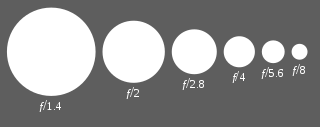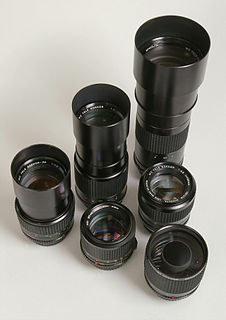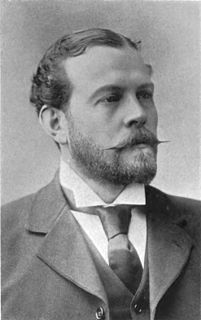
A camera is an optical instrument that can capture an image. Most cameras can capture 2D images, with some more advanced models being able to capture 3D images. At a basic level, most cameras consist of sealed boxes, with a small hole that allows light to pass through in order to capture an image on a light-sensitive surface. Cameras have various mechanisms to control how the light falls onto the light-sensitive surface. Lenses focus the light entering the camera, and the aperture can be narrowed or widened. A shutter mechanism determines the amount of time the photosensitive surface is exposed to the light.

A pinhole camera is a simple camera without a lens but with a tiny aperture —effectively a light-proof box with a small hole in one side. Light from a scene passes through the aperture and projects an inverted image on the opposite side of the box, which is known as the camera obscura effect. The size of the images depends on the distance between the object and the pinhole.
The focal length of an optical system is a measure of how strongly the system converges or diverges light; it is the inverse of the system's optical power. A positive focal length indicates that a system converges light, while a negative focal length indicates that the system diverges light. A system with a shorter focal length bends the rays more sharply, bringing them to a focus in a shorter distance or diverging them more quickly. For the special case of a thin lens in air, a positive focal length is the distance over which initially collimated (parallel) rays are brought to a focus, or alternatively a negative focal length indicates how far in front of the lens a point source must be located to form a collimated beam. For more general optical systems, the focal length has no intuitive meaning; it is simply the inverse of the system's optical power.

In optics, the f-number of an optical system such as a camera lens is the ratio of the system's focal length to the diameter of the entrance pupil. It is also known as the focal ratio, f-ratio, or f-stop, and is very important in photography. It is a dimensionless number that is a quantitative measure of lens speed; increasing the f-number is referred to as stopping down. The f-number is commonly indicated using a lower-case hooked f with the format f/N, where N is the f-number.
The angle of view is the decisive variable for the visual perception of the size or projection of the size of an object.

A camera lens is an optical lens or assembly of lenses used in conjunction with a camera body and mechanism to make images of objects either on photographic film or on other media capable of storing an image chemically or electronically.

In photography and cinematography, a wide-angle lens refers to a lens whose focal length is substantially smaller than the focal length of a normal lens for a given film plane. This type of lens allows more of the scene to be included in the photograph, which is useful in architectural, interior and landscape photography where the photographer may not be able to move farther from the scene to photograph it.

A telephoto lens, in photography and cinematography, is a specific type of a long-focus lens in which the physical length of the lens is shorter than the focal length. This is achieved by incorporating a special lens group known as a telephoto group that extends the light path to create a long-focus lens in a much shorter overall design. The angle of view and other effects of long-focus lenses are the same for telephoto lenses of the same specified focal length. Long-focal-length lenses are often informally referred to as telephoto lenses, although this is technically incorrect: a telephoto lens specifically incorporates the telephoto group.

A fisheye lens is an ultra wide-angle lens that produces strong visual distortion intended to create a wide panoramic or hemispherical image. Fisheye lenses achieve extremely wide angles of view, well beyond any rectilinear lens. Instead of producing images with straight lines of perspective, fisheye lenses use a special mapping, which gives images a characteristic convex non-rectilinear appearance.

Cosina Co., Ltd. is a manufacturer of high-end optical glass, optical precision equipment, cameras, video and electronic related equipment, based in Nakano, Nagano Prefecture, Japan.

A gnomonic map projection is a map projection which displays all great circles as straight lines, resulting in any straight line segment on a gnomonic map showing a geodesic, the shortest route between the segment's two endpoints. This is achieved by casting surface points of the sphere onto a tangent plane, each landing where a ray from the center of the sphere passes through the point on the surface and then on to the plane. No distortion occurs at the tangent point, but distortion increases rapidly away from it. Less than half of the sphere can be projected onto a finite map. Consequently, a rectilinear photographic lens, which is based on the gnomonic principle, cannot image more than 180 degrees.
Rectilinear means related to a straight line; it may refer to:
In geometric optics, distortion is a deviation from rectilinear projection; a projection in which straight lines in a scene remain straight in an image. It is a form of optical aberration.

John Henry Dallmeyer, Anglo-German optician, was born at Loxten, Westphalia, the son of a landowner.

Thomas Rudolphus Dallmeyer, English optician, was the son of John Henry Dallmeyer who ran an optics business. His maternal grandfather, Andrew Ross, was himself the first English photographic optician.

In photography, a rectilinear lens is a photographic lens that yields images where straight features, such as the edges of walls of buildings, appear with straight lines, as opposed to being curved. In other words, it is a lens with little or no barrel or pincushion distortion. At particularly wide angles, however, the rectilinear perspective will cause objects to appear increasingly stretched and enlarged as they near the edge of the frame. These types of lenses are often used to create forced perspective effects.

An ultra wide-angle lens is a lens whose focal length is shorter than that of an average wide-angle lens, providing an even wider view. The term denotes a different range of lenses, relative to the size of the sensor in the camera in question.
The design of photographic lenses for use in still or cine cameras is intended to produce a lens that yields the most acceptable rendition of the subject being photographed within a range of constraints that include cost, weight and materials. For many other optical devices such as telescopes, microscopes and theodolites where the visual image is observed but often not recorded the design can often be significantly simpler than is the case in a camera where every image is captured on film or image sensor and can be subject to detailed scrutiny at a later stage. Photographic lenses also include those used in enlargers and projectors.

The Nikkor 13mm f/5.6 is an ultra-wide angle rectilinear lens which was manufactured by Nikon for use on Nikon 135 film format SLR cameras until 1998, at which time it was discontinued. It has been dubbed 'The Holy Grail', for its low-distortion ultra-wide capabilities. The lens was produced by Nikon only upon receipt of an order, thus making it one of the Nikon lenses with the least number manufactured.

The invention of the camera in the early 19th century led to an array of lens designs intended for photography. The problems of photographic lens design, creating a lens for a task that would cover a large, flat image plane, were well known even before the invention of photography due to the development of lenses to work with the focal plane of the camera obscura.
















